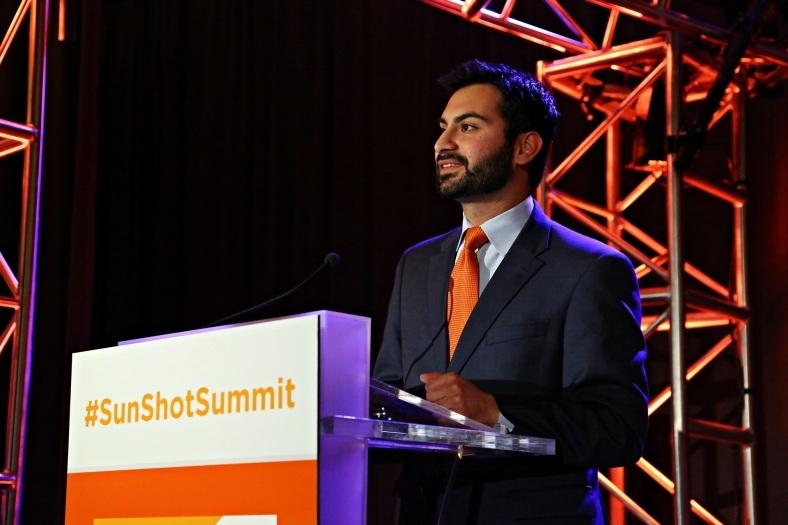
Last week was a busy and eventful one for the solar energy industry as market participants from across the U.S., and around the world, gathered in Anaheim, Calif. for the Department of Energy's (DOE) SunShot Grand Challenge Summit 2014. Among the highlights of the four-day summit: The DOE announced funding for six new concentrating solar power-thermochemical energy storage (TCES) R&D projects and launched SunShot Catalyst, a $1 million crowdsourcing contest that the Energy Department believes can accelerate the pace of solar energy innovation and cost reductions.
The SunShot Grand Challenge Summit 2014's event calendar was chock full of Obama administration and industry heavyweights and thought leaders, including ARPA-E's Dr. Cheryl Martin, the National Renewable Energy Laboratory's (NREL) Dan Arvizu, and the White House Office of Science and Technology Policy's Cristin Dorgelo.
Commenting on President Barack Obama's SunShot Initiative, the White House Domestic Policy Council's Ali Zaidi stated, “If moonshot was a race away from our planet, SunShot, in a way, is a race to save our planet.”
Crowdsourcing innovation to bring down solar energy soft costs
The overriding aim of the summit was to focus attention and rally industry participants and policy makers around making a concerted “push” to realize the 40 percent reduction in solar energy costs that would achieve the SunShot Initiative's goal: bringing the cost of solar energy down to 6 cents per kilowatt-hour (kWh), a levelized cost on par or below that of “other non-renewable sources of electricity generation.”
Providing impetus for the effort, the DOE announced the launch of the SunShot Catalyst Program. With the aim of accelerating breakthroughs capable of driving the "soft costs" of solar energy lower and thereby bringing the overall cost of solar energy down to the SunShot Initiative goal of 6 cents per kWh.
The DOE's SunShot Catalyst, through a series of prize challenges, “makes it faster and easier for American innovators to launch cutting-edge solar companies, while tackling time-sensitive market challenges.”
Consisting of four steps, SunShot Catalyst's winning contestants will receive awards totaling $1 million, including some $500,000 in cash prizes. Up to five winners in Step One, the “Ideation” stage, will take home $1,000 in cash each.
As many as 20, Step Two “Business Innovation” winners will receive $25,000 in services. Up to 20 finalists in the Step Three “Prototype” stage will advance to Step Four, the “Incubation” stage. As many as five Step Five winners will each earn a prize package valued at up to $100,000. The first cash prizes are to be announced on Feb. 9, 2015.
In addition to the cash prizes and packages, the DOE will provide unparalleled support to help assure SunShot Catalyst contestants succeed. All contestants, for instance, will gain access “to the vast array of tools, capabilities, data assets and additional resources” developed by the Energy Department and national labs. That includes tapping into “the nation's growing networks of technology mentors, incubators, and accelerators.” Check out the video for more:
$10 million SunShot funding for concentrating solar power-thermochemical energy storage
As 3p has been reporting, a new iteration of utility-scale concentrating solar power plants (CSP) capable of supplying clean, renewable electricity 24 hours a day, seven days a week is coming online. Integrating high-density thermochemical energy storage systems (TCES) with CSP plants, Energy Department funding and support has been pivotal in achieving this milestone.
As the Energy Department explains, its “CSP ELEMENTS”–Efficiently Leveraging Equilibrium Mechanisms for Engineering New Thermochemical nergy Storage (TCES)–funding program supports development of TCES systems “that can validate a cost of less than or equal to $15 per kilowatt-hour-thermal (kWht) and operate at temperatures greater than or equal to 650 degrees Celsius."
As the Energy Department explains,
“TCES presents opportunities for storing the sun's energy at high densities in the form of chemical bonds for use in utility-scale concentrating solar power (CSP) electricity generation.”
During last week's SunShot summit, the Energy Department announced $10 million in new CSP ELEMENTS funding for six R&D projects. From the DOE's CSP ELEMENTS website, here's the list of awardees and a brief description of their R&D projects:
- Colorado School of Mines, SunShot Award Amount: $1,008,511
- Pacific Northwest National Laboratory, SunShot Award Amount: $2,906,415
- Sandia National Laboratories, SunShot Award Amount: $3,450,000
- Southern Research Institute, SunShot Award Amount: $836,697
- University of Florida, SunShot Award Amount: $791,200
- University of California, Los Angeles, SunShot Award Amount: $1,182,788
Image courtesy of the SunShot Grand Challenge Summit

An experienced, independent journalist, editor and researcher, Andrew has crisscrossed the globe while reporting on sustainability, corporate social responsibility, social and environmental entrepreneurship, renewable energy, energy efficiency and clean technology. He studied geology at CU, Boulder, has an MBA in finance from Pace University, and completed a certificate program in international governance for biodiversity at UN University in Japan.














